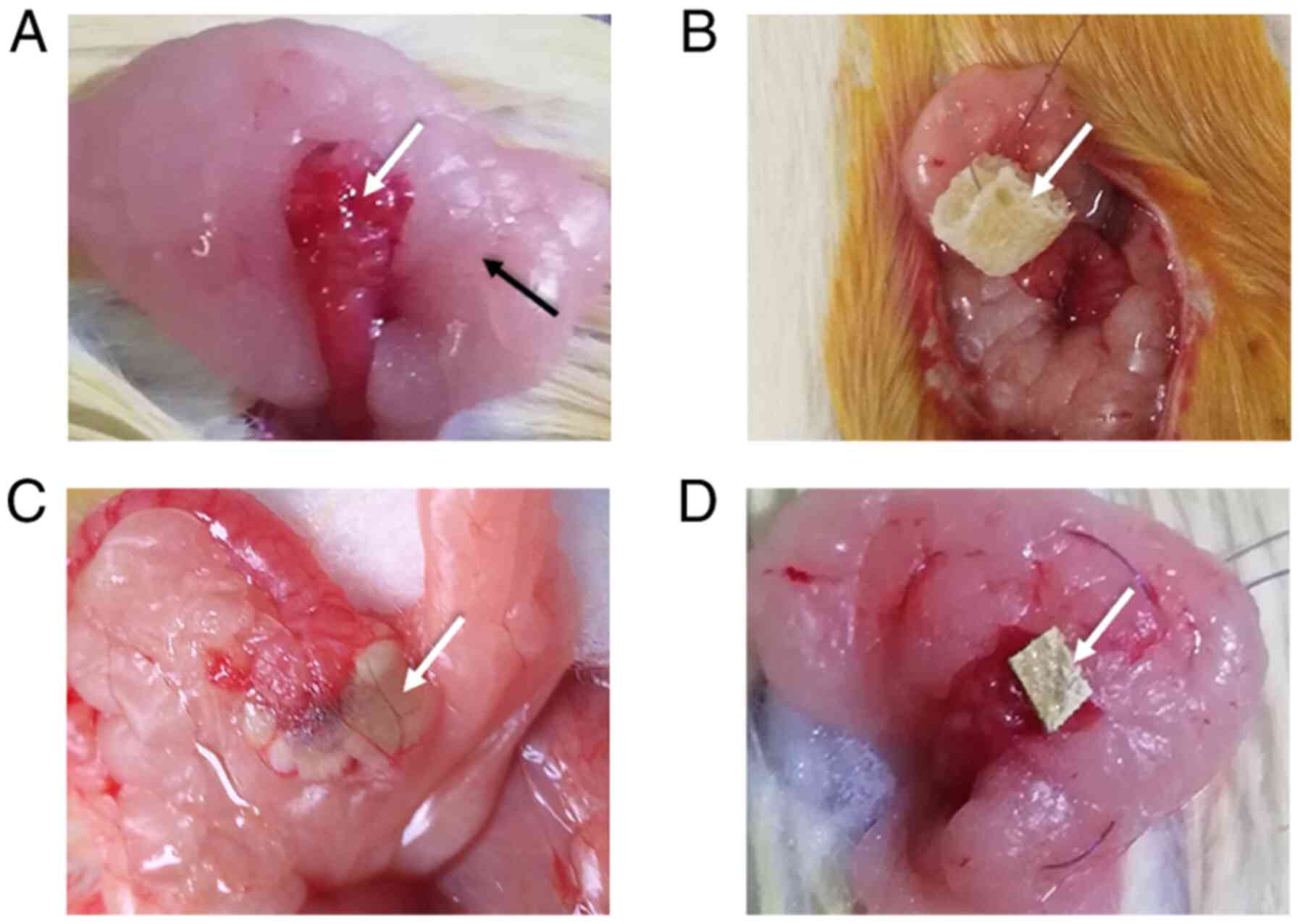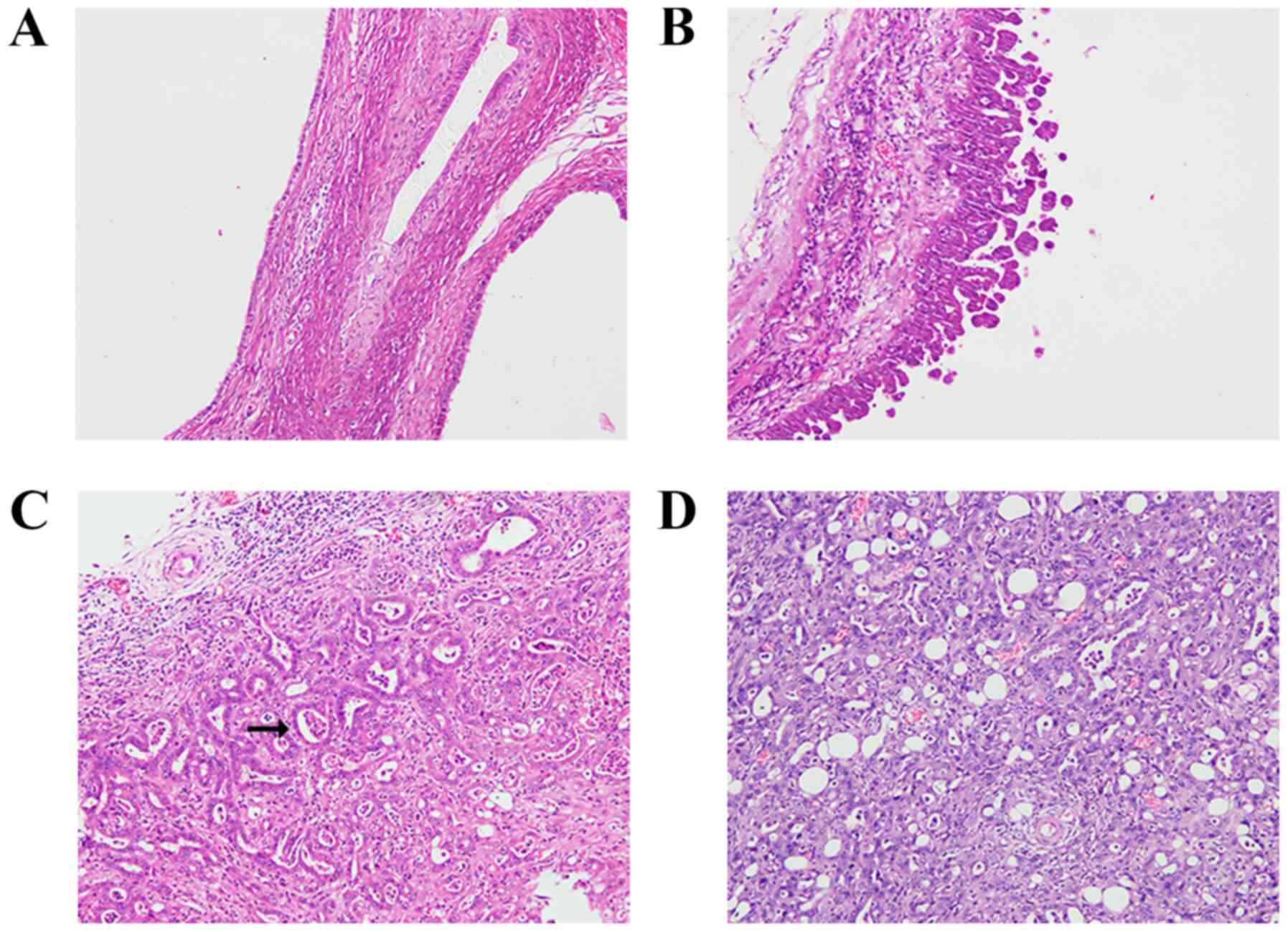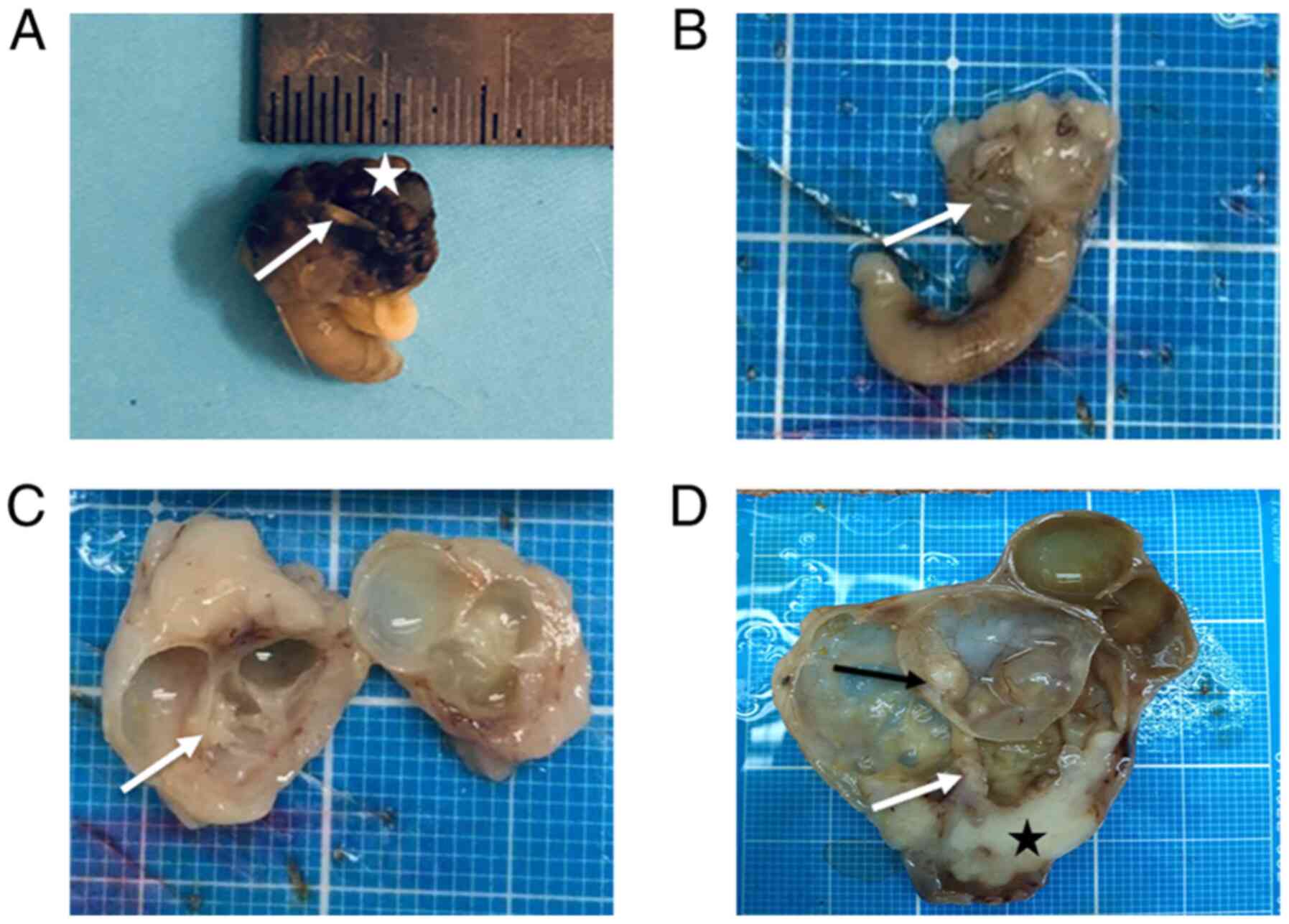|
1
|
Bray F, Ferlay J, Soerjomataram I, Siegel
RL, Torre LA and Jemal A: Global cancer statistics 2018: GLOBOCAN
estimates of incidence and mortality worldwide for 36 cancers in
185 countries. CA Cancer J Clini. 68:394–424. 2018. View Article : Google Scholar
|
|
2
|
Kurman RJ, Carcangiu ML, Herrington CS and
Yong RH: WHO Classification of Tumours of Female Reproductive
Organs. 6. 4th edition. Lyon: IARC Press, Lyon; pp. pp3072014
|
|
3
|
Prat J: Ovarian carcinomas: Five distinct
diseases with different origins, genetic alterations, and
clinicopathological features. Virchows Arch. 460:237–249. 2012.
View Article : Google Scholar : PubMed/NCBI
|
|
4
|
Malpica A, Deavers MT, Tornos C, Kurman
RJ, Soslow R, Seidman JD, Munsell MF, Gaertner E, Frishberg D and
Silva EG: Interobserver and intraobserver variability of a two-tier
system for grading ovarian serous carcinoma. Am J Surg Pathol.
31:1168–1174. 2007. View Article : Google Scholar : PubMed/NCBI
|
|
5
|
Shih IeM and Kurman RJ: Ovarian
tumorigenesis: A proposed model based on morphological and
molecular genetic analysis. Am J Pathol. 164:1511–1518. 2004.
View Article : Google Scholar : PubMed/NCBI
|
|
6
|
Marinaş MC, Mogoş G, Ciurea R and Mogoş
DG: EGFR, HER2/neu and Ki67 immunoexpression in serous ovarian
tumors. Rom J Morphol Embryol. 53:563–567. 2012.PubMed/NCBI
|
|
7
|
Sieben NL, Macropoulos P, Roemen GM,
Kolkman-Uljee SM, Jan Fleuren G, Houmadi R, Diss T, Warren B, Al
Adnani M, De Goeij AP, et al: In ovarian neoplasms, BRAF, but not
KRAS, mutations are restricted to low-grade serous tumors. J
Pathol. 202:336–340. 2004. View Article : Google Scholar : PubMed/NCBI
|
|
8
|
Singer G, Stohr R, Cope L, Dehari R,
Hartmann A, Cao DF, Wang TL, Kurman RJ and Shih IeM: Patterns of
p53 mutations separate ovarian serous borderline tumors and low-
and high-grade carcinomas and provide support for a new model of
ovarian carcinogenesis: A mutational analysis with
immunohistochemical correlation. Am J Surg Pathol. 29:218–224.
2005. View Article : Google Scholar : PubMed/NCBI
|
|
9
|
Siegel RL, Miller KD and Jemal A: Cancer
statistics, 2019. CA Cancer J Clin. 69:7–34. 2019. View Article : Google Scholar : PubMed/NCBI
|
|
10
|
Irodi A, Rye T, Herbert K, Churchman M,
Bartos C, Mackean M, Nussey F, Herrington CS, Gourley C and Hollis
RL: Patterns of clinicopathological features and outcome in
epithelial ovarian cancer patients: 35 years of prospectively
collected data. BJOG. 127:1409–1420. 2020. View Article : Google Scholar : PubMed/NCBI
|
|
11
|
Stewart C, Ralyea C and Lockwood S:
Ovarian cancer: An integrated review. Semin Oncol Nurs. 35:151–156.
2019. View Article : Google Scholar : PubMed/NCBI
|
|
12
|
Stakleff KD and Von Gruenigen VE: Rodent
models for ovarian cancer research. Int J Gynecol Cancer.
13:405–412. 2003. View Article : Google Scholar : PubMed/NCBI
|
|
13
|
Hoyer PB, Davis JR, Bedrnicek JB, Marion
SL, Christian PJ, Barton JK and Brewer MA: Ovarian neoplasm
development by 7,12-dimethylbenz(a)anthracene (DMBA) in a
chemically-induced rat model of ovarian failure. Gynecol Oncol.
112:610–615. 2009. View Article : Google Scholar : PubMed/NCBI
|
|
14
|
Stewart SL, Querec TD, Ochman AR, Gruver
BN, Bao R, Babb JS, Wong TS, Koutroukides T, Pinnola AD,
Klein-Szanto A, et al: Characterization of a carcinogenesis rat
model of ovarian preneoplasia and neoplasia. Cancer Res.
64:8177–8183. 2004. View Article : Google Scholar : PubMed/NCBI
|
|
15
|
Krarup T: Oocyte destruction and ovarian
tumorgenesis after direct application of a chemical carcinogen
(9:10-dimethyl-1:2-benzanthrene) to the mouse ovary. Int J Cancer.
4:61–75. 1969. View Article : Google Scholar : PubMed/NCBI
|
|
16
|
Kuwahara I: Experimental induction of
ovarian tumors in mice treated with single administration of
7,12-dimethylbenz(a)anthracene, and its histopathological
observation. Gan. 58:253–266. 1967.PubMed/NCBI
|
|
17
|
Huang Y, Jiang W, Wang Y, Zheng Y, Cong Q
and Xu C: Enhanced efficacy and specificity of epithelial ovarian
carcinogenesis by embedding a DMBA-coated cloth strip in the ovary
of rat. J Ovarian Res. 5:212012. View Article : Google Scholar : PubMed/NCBI
|
|
18
|
Cai SQ, Li Y, Li YA, Wang L, Zhu J, Zhao
SH, Li X and Qiang JW: A rat model of serous borderline ovarian
tumors induced by 7,12-dimethylbenz(a)anthracene. Exp Anim.
68:257–265. 2019. View Article : Google Scholar : PubMed/NCBI
|
|
19
|
Tanaka YO, Okada S, Satoh T, Matsumoto K,
Oki A, Saida T, Yoshikawa H and Minami M: Differentiation of
epithelial ovarian cancer subtypes by use of imaging and clinical
data: A detailed analysis. Cancer Imaging. 16:32016. View Article : Google Scholar : PubMed/NCBI
|
|
20
|
Xue M, Ji X, Liang H, Liu Y, Wang B, Sun L
and Li W: The effect of fucoidan on intestinal flora and intestinal
barrier function in rats with breast cancer. Food Funct.
9:1214–1223. 2018. View Article : Google Scholar : PubMed/NCBI
|
|
21
|
Nishida T, Sugiyama T, Kataoka A, Ushijima
K and Yakushiji M: Histologic characterization of rat ovarian
carcinoma induced by intraovarian insertion of a
7,12-dimethylbenz(a)anthracene-coated suture: Common epithelial
tumors of the ovary in rats? Cancer. 83:965–970. 1998. View Article : Google Scholar : PubMed/NCBI
|
|
22
|
Rosenkrantz AB, Sigmund EE, Winnick A,
Niver BE, Spieler B, Morgan GR and Hajdu CH: Assessment of
hepatocellular carcinoma using apparent diffusion coefficient and
diffusion kurtosis indices: Preliminary experience in fresh liver
explants. Magn Reson Imaging. 30:1534–1540. 2012. View Article : Google Scholar : PubMed/NCBI
|
|
23
|
Mori N, Ota H, Mugikura S, Takasawa C,
Ishida T, Watanabe G, Tada H, Watanabe M, Takase K and Takahashi S:
Luminal-type breast cancer: Correlation of apparent diffusion
coefficients with the Ki-67 labeling index. Radiology. 274:66–73.
2015. View Article : Google Scholar : PubMed/NCBI
|
|
24
|
Seidman JD and Mehrotra A: Benign ovarian
serous tumors: A re-evaluation and proposed reclassification of
serous ‘cystadenomas’ and ‘cystadenofibromas’. Gynecol Oncol.
96:395–401. 2005. View Article : Google Scholar : PubMed/NCBI
|
|
25
|
Li YA, Qiang JW, Ma FH, Li HM and Zhao SH:
MRI features and score for differentiating borderline from
malignant epithelial ovarian tumors. Eur J Radiol. 98:136–142.
2018. View Article : Google Scholar : PubMed/NCBI
|
|
26
|
Chui MH, Xing D, Zeppernick F, Wang ZQ,
Hannibal CG, Frederiksen K, Kjaer SK, Cope L, Kurman RJ, Shih IM,
et al: Clinicopathologic and molecular features of paired cases of
metachronous ovarian serous borderline tumor and subsequent serous
carcinoma. Am J Surg Pathol. 43:1462–1472. 2019. View Article : Google Scholar : PubMed/NCBI
|
|
27
|
Zhao SH, Qiang JW, Zhang GF, Boyko OB,
Wang SJ, Cai SQ and Wang L: MRI appearances of ovarian serous
borderline tumor: Pathological correlation. J Magn Reson Imaging.
40:151–156. 2014. View Article : Google Scholar : PubMed/NCBI
|
|
28
|
Zhao SH, Qiang JW, Zhang GF, Wang SJ, Qiu
HY and Wang L: MRI in differentiating ovarian borderline from
benign mucinous cystadenoma: Pathological correlation. J Magn Reson
Imaging. 39:162–166. 2014. View Article : Google Scholar : PubMed/NCBI
|
|
29
|
Tanaka T, Kohno H, Tanino M and Yanaida Y:
Inhibitory effects of estrogenic compounds, 4-nonylphenol and
genistein, on 7,12-dimethylbenz(a)anthracene-induced ovarian
carcinogenesis in rats. Ecotoxicol Environ Saf. 52:38–45. 2002.
View Article : Google Scholar : PubMed/NCBI
|
|
30
|
Tanaka T, Kohno H, Suzuki R and Sugie S:
Lack of modifying effects of an estrogenic compound atrazine on
7,12-dimethylbenz(a)anthracene-induced ovarian carcinogenesis in
rats. Cancer Lett. 210:129–137. 2004. View Article : Google Scholar : PubMed/NCBI
|
|
31
|
Liu L, Hu Z, Zhang H, Hou Y, Zhang Z, Zhou
G and Li B: Vitamin D postpones the progression of epithelial
ovarian cancer induced by 7, 12-dimethylbenz(a)anthracene both in
vitro and in vivo. Onco Targets Ther. 9:2365–2375. 2016. View Article : Google Scholar : PubMed/NCBI
|



















